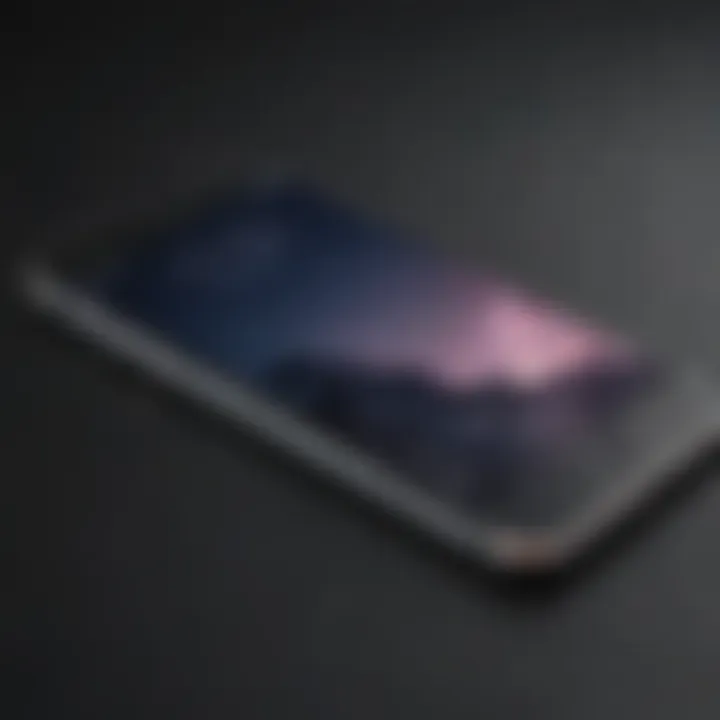Exploring the Dimensions and Specs of iPhone 6s


Product Overview
The iPhone 6s, released by Apple in September 2015, stands as a testament to the evolution of mobile technology. This model marked a significant step in design and functionality within the iPhone lineup. With an aluminum body and a sleek appearance, it was designed to be visually appealing while offering robust performance.
Key Features and Specifications
The iPhone 6s measures 138.3 x 67.1 x 7.1 mm, which makes it slim yet sturdy. It weighs 143 grams, striking a balance between lightweight design and durability. Notably, it features a 4.7-inch Retina display with a resolution of 1334 x 750 pixels, ensuring vibrant visuals and clarity. The inclusion of the A9 chip enhanced its performance, enabling faster processing and improved graphics handling.
Design and Aesthetics
In terms of design, the iPhone 6s introduced a rose gold color option, alongside the traditional silver, gold, and space gray. This expanded color palette appealed to a broad audience. The device's design reflects Apple's commitment to minimalist aesthetics, with clean lines and a solid feel, contributing to its effective user experience.
Performance and User Experience
Performance Benchmarks
The iPhone 6s achieved impressive benchmark scores, thanks to its A9 chip and M9 motion coprocessor. Tests showed significant improvements over its predecessor, the iPhone 6, especially in multitasking and gaming applications. It supported up to 2GB of RAM, enhancing its ability to handle multiple applications efficiently.
User Interface and Software Capabilities
Operating on iOS 9 during its launch, the device introduced features such as Live Photos, giving users unique capabilities for capturing memories. The interface remained intuitive, enabling easy navigation for both new and experienced users. Its compatibility with various apps and updates further solidified its user-friendly nature.
User Experiences and Feedback
User feedback highlighted the device's compact size and solid build quality as notable strengths. Many users appreciated the improved camera functionality, particularly the 12-megapixel rear camera, which made photography straightforward and enjoyable. However, some users expressed disappointment about battery life, especially during heavy use.
Comparison with Previous Models or Competitors
Advancements and improvements from previous models
The iPhone 6s brought several advancements compared to the iPhone 6. Notably, the inclusion of 3D Touch revolutionized user interaction, allowing for pressure-sensitive gestures. Furthermore, the upgraded camera and processing capabilities set it apart from older models, making it a strong contender in the smartphone market.
Competitive analysis with other similar products
When compared to competitors such as the Samsung Galaxy S6, the iPhone 6s held its ground. While both devices offered similar dimensions and specifications, user loyalty often swayed preferences. Apple’s ecosystem provided a seamless experience for existing Apple users, making the iPhone 6s a compelling choice.
Value Proposition
The iPhone 6s's combination of design, performance, and brand loyalty collectively contributed to its value proposition. Even years after its release, it remains a relevant option for users seeking reliable performance in a compact form factor.
Tips and Tricks
How-to guides and tutorials for optimizing the Apple product's performance
Users can enhance the performance of their iPhone 6s by regularly updating their software and managing background apps. This will ensure smoother functionality and effective battery management.
Hidden features and functionalities
Many users are unaware of features like the ability to record Live Photos or use 3D Touch shortcuts. Learning these can significantly enhance the user experience.
Troubleshooting common issues
For common issues such as sluggish performance, users can try resetting settings or freeing up storage space to improve speed and responsiveness.
Latest Updates and News
Recent developments in software updates and new features


With the release of iOS updates, features like improved Siri capabilities and security enhancements were introduced to the iPhone 6s. Staying updated ensures access to the latest functionalities.
Industry news and rumors surrounding upcoming products
Rumors about new models continue to circulate. Many experts speculate whether Apple will incorporate features originally seen in the iPhone 6s into newer devices, indicating its lasting impact on Apple's design and development philosophy.
Events and announcements from Apple
Updates from Apple’s annual events often highlight advancements in technology. Such announcements provide insights into the tech giant’s future direction, impacting current device usage and expectations.
The iPhone 6s remains a significant part of Apple’s narrative, illustrating the brand's commitment to innovation and user satisfaction.
This analysis serves to provide a comprehensive understanding of the iPhone 6s, its place in mobile technology history, and its enduring relevance in an ever-evolving market.
Foreword
The dimensions and specifications of any smartphone are critical parameters that define its appeal and functionality. The iPhone 6s, launched by Apple in 2015, plays a significant role in Apple's history and mobile technology at large. Not only does its size influence how users interact with the device, but it also sets a standard for ergonomic design in phones.
In this article, we will explore the iPhone 6s from multiple angles, focusing largely on its physical dimensions, weight, and build quality. These elements are essential for those considering this device, as they impact usability and portability. Furthermore, understanding these specifications provides insights into the device's performance relative to other models.
The iPhone 6s offers more than just fitting in the hand of its user; it is an embodiment of design philosophy that seeks to balance aesthetics with functionality. This analysis is intended for Apple aficionados, tech enthusiasts, and professionals in the technology sector. We aim to provide a thorough examination of the iPhone 6s that highlights its relevance in today’s mobile landscape.
iPhone 6s Overview
The iPhone 6s is a vital piece of Apple's smartphone portfolio, notable for its unique blend of size, design, and technology. It serves as an intermediary model that bridges the gap between the iPhone 6 and the subsequent iterations, encapsulating significant advancements in both hardware and software. Understanding the iPhone 6s not only reveals insights into Apple's design philosophy but also highlights its influence on mobile technology standards.
Historical Context
When considering the historical context of the iPhone 6s, it is essential to recognize the broader evolution of the smartphone market. Released in September 2015, the iPhone 6s arrived at a time when smartphones were becoming pivotal to daily life. With the growth of social media and mobile applications, users sought devices that offered more than just calling and texting. The iPhone 6s aimed to meet these needs with compelling features like the introduction of 3D Touch, which added a new layer of interaction through pressure sensitivity.
The iPhone 6s filled a critical role in Apple's lineup, incorporating the design language initiated with the iPhone 6 while adding performance enhancements and refining usability. It represented a continuation of the trend towards larger displays and more powerful processors, setting the stage for further advancements in mobile technology.
Release Date and Market Reception
The official release date for the iPhone 6s was September 25, 2015. Upon launch, it received positive reviews from both critics and consumers, with many praising its performance and the improvements over its predecessor. The adoption of 12-megapixel cameras and the introduction of Live Photos resonated well with users who valued multimedia capabilities.
Market reception highlighted a nuanced appreciation for the iPhone 6s's dimensions and ergonomics. Users noted how the device felt solid in hand, a result of its aluminum unibody construction. This perceived premium build quality contributed significantly to customer satisfaction.
The introduction of the iPhone 6s reinforced Apple's position as a leader in mobile innovation, setting high expectations for future models.
Sales figures post-release confirmed its success. The iPhone 6s sold over 13 million units within the first three days, reflecting a strong demand driven by customer loyalty and interest in its new features. Overall, the iPhone 6s occupies a notable place in Apple's history, embodying a pivotal moment in the evolution of smartphones.
Physical Dimensions
Understanding the physical dimensions of the iPhone 6s is crucial for assessing its usability and overall user experience. This section elucidates how the device's height, width, depth, weight, and build quality contribute to its functionality and appeal. Criteria such as portability, feel in the hand, and design aesthetics are all influenced by dimensions. Such insights can aid potential buyers and enthusiasts in their evaluation of this model relative to contemporary options.
Height, Width, and Depth
The height, width, and depth of the iPhone 6s are pivotal in defining its ergonomic approach. The device measures 138.3 mm in height, 67.1 mm in width, and 7.1 mm in depth. These precise dimensions allow for a comfortable grip. The form factor encourages easy one-handed operation, making it user-friendly. This is significant as mobile technology evolves. Increasingly larger devices risk becoming cumbersome.
- The height is balanced to align with the thumb placement, thus enhancing ergonomics.
- The width is narrow enough to be comfortably held while providing a robust screen size.
- The depth is designed to maintain a sleek profile without sacrificing durability.
Physical dimensions are not merely numbers. They influence how users interact with their device daily.
Weight Considerations
Weight is another vital aspect when evaluating the iPhone 6s. Weighing approximately 143 grams, this phone strikes a balance between solid build and lightness. A heavier device can feel premium, yet it can also lead to discomfort during extended use. The iPhone 6s maintains a weight that supports prolonged handling without fatigue.


Key points include:
- The lightweight design aids portability, allowing users to carry the device without discomfort.
- A well-distributed weight enhances stability when typing or navigating the interface.
- Weight must be considered in tandem with build materials, as some heavier phones may feel less robust.
Ultimately, the weight of the iPhone 6s contributes to its overall user experience in a practical way.
Material and Build Quality
The build quality of the iPhone 6s speaks volumes about its craftsmanship. Constructed from 7000 series aluminum, it boasts improved durability versus previous iterations. This choice of materials is significant in resisting everyday wear and tear.
Key aspects of the materials used include:
- The aluminum body provides a premium feel and enhances aesthetics.
- It is also less prone to bending compared to materials previously used.
- The glass front, while sleek, has been treated to enhance resistance to scratches.
Overall, the material choices reinforce the design philosophies of Apple, focusing on both form and function. This blend enhances the longevity of the device while retaining its elegant appearance.
This focus on physical dimensions and build quality aligns with Apple’s ethos of delivering a top-notch user experience in mobile technology.
Screen Size and Display
The screen size and display of the iPhone 6s play a critical role in understanding the device's overall user experience. This section explores the display's specifications and the technology behind it, all contributing to its impact on usability and design. The iPhone 6s display is important for consuming media, interacting with apps, and performing daily tasks; therefore, it warrants a thorough examination.
Display Technology
The iPhone 6s features a Retina HD display, utilizing LCD technology. This display delivers vibrant colors and sharp images. With a size of 4.7 inches measured diagonally, it is designed to provide an optimal balance between usability and portability. The screen has a pixel resolution of 1334 x 750, which translates to a pixel density of roughly 326 pixels per inch (ppi).
Apple's technology focuses on providing high brightness and contrast ratios. The iPhone 6s also includes features such as Dual-domain pixels, which improve the screen's viewing angles, ensuring that colors remain consistent even when the device is viewed from the side.
Key Benefits of Display Technology:
- Vivid Colors: The display technology allows for a broader color range.
- Sharpness: The high pixel density makes text and images crisp, enhancing overall clarity.
- Viewing Angles: Improved technology enables an enjoyable viewing experience from various angles.
Resolution and Pixel Density
Resolution and pixel density are significant metrics in evaluating the display capabilities. The iPhone 6s boasts a resolution of 1334 x 750 pixels. This graduation from lower resolutions offers a more detailed picture that is vital for media consumption, gaming, and productivity.
A notable feature of the iPhone 6s display is its support for 3D Touch technology, which enables different response types based on the pressure applied to the screen. This adds an additional layer of interaction, making the touch experience more responsive and intuitive for users.
"Display quality significantly affects user satisfaction and engagement with the device, turning simple tasks into enjoyable experiences."
The combination of resolution and pixel density ensures that most applications run smoothly, providing an immersive experience. Whether reading, watching videos, or browsing, users appreciate crisp visuals and vibrant color accuracy. Therefore, the iPhone 6s display technology positions it favorably amongst its contemporaries.
In summary, the screen size and display technology of the iPhone 6s influence usability and user perception directly. With advancements in display quality, Apple managed to enhance the ways users engage with their devices.
Comparative Size Analysis
The Comparative Size Analysis section plays a crucial role in understanding the iPhone 6s within its technological landscape. Analyzing dimensions and sizes against previous and current iPhone models elucidates how design choices evolved over time. This aspect not only highlights trends but also showcases user preferences and changing market demands.
In a rapidly advancing tech world, discerning differences between models can inform purchasing decisions. This analysis provides insights into how the iPhone 6s fits within the broader Apple ecosystem, emphasizing both its strengths and limitations in comparison to its peers.
Comparison to Previous iPhone Models
When contrasting the iPhone 6s with its predecessors, such as the iPhone 6, one can observe subtle yet significant distinctions. The iPhone 6s maintained the same height and width as the iPhone 6, which was a deliberate choice to ensure compatibility with existing cases and accessories. However, it introduced a modest increase in thickness by 0.2 mm. This change, though slight, allows for enhanced durability while also accommodating new features like 3D Touch.
The comparative dimensions can be summarized as follows:
- iPhone 6: 138.1 x 67.0 x 6.9 mm
- iPhone 6s: 138.3 x 67.1 x 7.1 mm


Another key element to mention is the weight. The iPhone 6s weighs 143 grams compared to the 129 grams of the iPhone 6. This increase is due to the inclusion of a stronger series 7000 aluminum and additional internal components, particularly the Taptic Engine which delivers new haptic feedback features.
With these changes, the iPhone 6s not only provides a slightly more robust feel in hand but also enhances functionality, effectively bridging the gap between usability and aesthetics.
Comparison to Current iPhone Models
In the context of Apple's latest offerings, the iPhone 6s stands out both in its size and overall device philosophy. When comparing it to the iPhone 13 or iPhone 14, one noted dimension is that today's models are increasingly optimized for larger displays without significantly increasing the overall footprint.
Consider these comparisons for context:
- iPhone 13: 146.7 x 71.5 x 7.65 mm
- iPhone 6s: 138.3 x 67.1 x 7.1 mm
This demonstrates how newer models have embraced larger screens while still attempting to maintain user comfort and durability. The iPhone 6s, with its smaller size, can feel more manageable in one hand compared to larger models. However, this smaller form factor limits the display area for multimedia consumption, which has become a crucial feature in modern devices.
A smaller device may offer easier handling, yet it trades off on screen real estate which has become ever more important today.
Overall, the comparative size analysis reveals that while the iPhone 6s was a key step forward in design, its dimensions are emblematic of a device aimed at a specific moment in time—one that balanced portability and cutting-edge features, setting the stage for future innovations.
User Experience Relative to Size
The size of a device has a profound influence on user experience. When examined within the context of the iPhone 6s, its dimensions contribute significantly to how users interact with the device. This encompasses not only how it fits in the hand but also how it integrates into daily activities. The combination of form factor, ergonomics, and overall handling can either enhance or detract from the user’s enjoyment and efficiency with the device.
Ergonomics and Handling
The ergonomics of the iPhone 6s are thoughtfully engineered. With a height of 138.3 mm, width of 67.1 mm, and depth of 7.1 mm, it is designed to comfortably fit in a typical adult hand. Users can easily reach all areas of the display with one hand, an important factor in mobile technology where touchscreen interaction is key. This capability enhances usability, allowing for seamless navigation through apps and functions.
In terms of handling, the iPhone 6s features an aluminum body that is not only lightweight but also offers a premium feel. The matte finish provides grip without making the device cumbersome. Users tend to find that the curved edges and slightly rounded corners further contribute to its comfortable hold. It is a balance of design and functionality that elevates the overall user experience, proving that physical dimensions are not just numbers but integral to user satisfaction.
Portability and Use Cases
Portability is another critical aspect of the user experience. The iPhone 6s weighs 143 grams, making it one of the lighter smartphones on the market at the time of its release. This reduced weight allows users to carry it effortlessly in a pocket or bag. The compact size also means that it can be used easily in various situations – whether typing a message while standing in line, taking photos on a hike, or catching up on work during a commute.
However, portability does bring with it certain trade-offs. While the dimensions make the iPhone 6s easy to transport, they also limit the screen size compared to larger models. Users who prefer larger displays for activities like gaming or video consumption may find the screen size of the iPhone 6s less optimal for their needs. Therefore, the ideal use cases for the iPhone 6s include those requiring ease of access and quick interactions, highlighting its suitability for everyday life rather than power-intensive tasks.
Market Influence and Legacy
The iPhone 6s holds a significant place in the chronology of mobile devices, not just for its specifications but also for the impact it made on the market. Understanding this influence is crucial for grasping the broader context of its legacy. This section emphasizes the iPhone 6s's role in solidifying Apple's position in the smartphone arena, showcasing elements such as user preferences, aesthetic trends, and technological advancements. The blend of familiarity in design with unique features allowed the iPhone 6s to cater to a wide audience, thus enhancing its market reach.
Cultural Impact of the iPhone 6s Size
The dimensions of the iPhone 6s were pivotal in shaping its cultural presence. With a size that struck a balance between usability and portability, the device appealed to diverse consumer groups. Its 4.7-inch screen was deemed optimal for one-handed use while still delivering engaging multimedia experiences. This led to a rise in similar-sized smartphones in the following years.
Moreover, the design felt courageous yet elegant. It influenced not only consumer choices but also industry design paradigms. Many manufacturers started to shift their focus to rival models with similar dimensions and aesthetics. This shift is evidenced by the emergence of phablets, which eroded the gap between traditional phones and larger devices, a market trend that persists today.
"The iPhone 6s demonstrated how dimensions can define user interaction and, consequently, cultural acceptance of a device."
Enduring Design Principles from iPhone 6s
The principles established by the iPhone 6s resonate in the designs of many mobile devices today. Its focus on simplicity, functionality, and premium materials defines a standard that manufacturers aspire to achieve. The use of aluminum in its exterior has become a benchmark for build quality. Additionally, the emphasis on sleek lines and fewer buttons has prompted many brands to streamline their designs.
The iPhone 6s also popularized the practice of using chamfered edges, which enhanced not only aesthetic appeal but also improved grip and handling. The design choices made during its development have had lasting influences on subsequent iPhones and devices from other brands, leading to a common visual language in modern smartphones.
End
In concluding this examination of the iPhone 6s dimensions and specifications, it's essential to recognize the significance of its physical attributes and user experience. The iPhone 6s retains a crucial position within Apple's lineup, primarily due to its balanced form factor. While it may appear modest by current standards, its design laid the groundwork for various future models.
Fundamentals of the iPhone 6s include its dimensions: 138.3 mm in height, 67.1 mm in width, and 7.1 mm in depth. This compact build facilitates easy handling and operation, which has resonated with users. Moreover, weighing in at 143 grams, the device offers a lightweight experience that prevails in today's portable technology environment.
Another important consideration is the cultural impact of the device's size. As technology evolved, the iPhone 6s marked a transition in smartphone design perspectives. Customers began to prioritize not only function and features but also the comfortable ergonomics offered by smaller devices.
The legacy of the iPhone 6s extends beyond its initial appeal. Insights about its durability and design have been echoed in subsequent releases. The principles that governed its design continue to influence Apple's future endeavors, resonating with Apple aficionados and tech enthusiasts alike.
"The iPhone 6s demonstrates that size and performance can co-exist harmoniously."
In summary, the analysis provided illustrates that the iPhone 6s is more than just its specifications. Its form factor, user experience, and market influence portray a device that significantly contributed to shaping the smartphone industry. Gaining an understanding of these aspects gives a richer context and appreciation for the device's role in modern technology.



